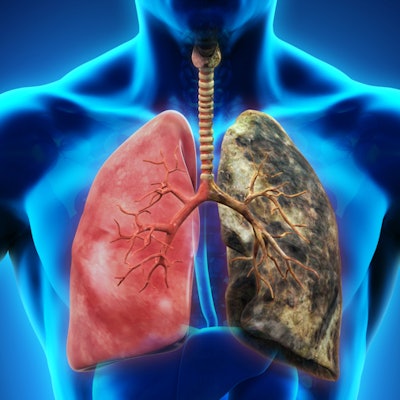
A new analysis of the Multicentric Italian Lung Detection (MILD) trial has shown that biennial CT lung cancer screening was just as effective as annual screening in reducing the risk of lung cancer and all-cause mortality. The study was published in the September issue of the European Journal of Cancer.
The initial report of the prospective, randomized MILD trial showed that CT lung screening achieved a 39% reduction in the risk of lung cancer death for eligible Italian smokers up to 10 years after baseline screening.
For the current study, the researchers from the Istituto di Ricovero e Cura a Carattere Scientifico (IRCCS) at the National Cancer Institute of Milan compared the outcomes of the 2,376 participants in the MILD trial who underwent follow-up CT lung screening once each year following the first exam and those who underwent a follow-up screening exam every two years (Eur J Cancer, September 2019, Vol.118, pp. 142-148).
The standard approach to lung cancer surveillance after a negative screening exam is follow-up CT on an annual basis, but several recent studies have hinted at the possible advantages of biennial over annual screening, especially when combined with personalized risk stratification, first author Dr. Ugo Pastorino and colleagues noted.
"Such low-intensity approach is also convenient to minimize medical risk (e.g., procedure-related morbidity and mortality), psychological stress, economic burden, and added oncologic risk from radiation exposure," they wrote.
After analyzing the data, the team found that the all-cause mortality and lung cancer mortality rates for the 10-year period were nearly the same for individuals who underwent annual or biennial follow-up screening. The biennial group had a slightly lower all-cause mortality rate (hazard ratio of 0.8) and a slightly higher lung cancer mortality rate (hazard ratio of 1.1), though the differences were not statistically significant.
| Annual vs. biennial CT lung cancer screening in the MILD trial | ||
| Annual screening | Biennial screening | |
| Lung cancer incidence | 4.9% | 3.4% |
| All-cause mortality rate per 100,000 persons | 659.7 | 527.6 |
| Lung cancer mortality rate per 100,000 persons | 164.9 | 181.6 |
| No. of follow-up CT exams performed | 6,217 | 3,855 |
Overall, biennial and annual CT lung screening offered similar reductions to all-cause and lung cancer mortality, but biennial screening required roughly 40% fewer CT exams than annual screening did. There was also no difference between the groups in the detection of late-stage or interval lung cancers.
This similarity in outcomes suggests that biennial CT lung screening may be a favorable alternative to annual screening -- requiring fewer CT exams and likely decreasing hospital costs and patient exposure to radiation, the authors noted. Relying on risk stratification techniques to selectively identify which individuals would benefit most from biennial CT lung screening could further optimize the screening process.
"Individual risk stratification by radiomic and artificial intelligence analysis of baseline [CT lung screening] findings represents a promising development for future screening programs, to improve the efficacy of limited healthcare resources and reduce costs," they wrote.



















